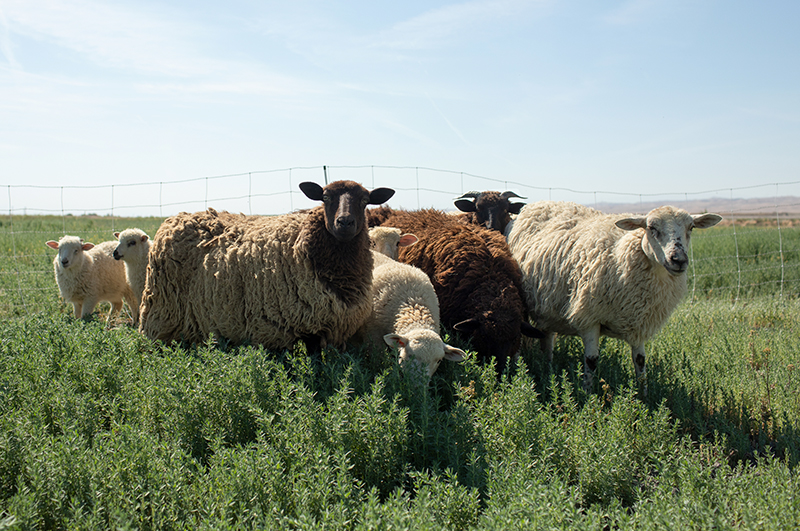
Looking to the Past to Make Clothing for Our Future
by Sheryl Karas MA, CRARS staff

When you pick out your clothes in the morning, do bucolic visions of fields of cotton or sheep come to mind? If you are over 50 maybe they do. In 1960 almost all the clothing worn in the United States was made of natural fibers and 95% of it was made in the United States. But for most young people today, farming isn’t associated with clothing at all. 97% of our clothing is imported from overseas, mostly from Asia and Southeast Asia, and about 2/3 of our clothing no longer depends on farming. It is made of polyester, a product of the petrochemical industry, using an estimated 342 million barrels of oil every year.
From a short-term point of view, this has had some positive benefits. Polyester clothing is often stronger and lasts longer, more easily stretches and resists wrinkling, and, when made overseas, is far less expensive. That means clothing is more affordable now(opens in new window), comprising far less of an American family’s budget than it did in the 1960s, despite people buying far more pieces of clothing every year. And, certainly, clothing producers save money by using less expensive labor.
On the other hand, it has been devastating for the environment and for our local economies. Oil is not a renewable resource, and making fabric from petrochemicals is a highly polluting industry. It uses a lot of energy (125 MJ of energy per kilogram produced) and is a significant contributor to greenhouse gasses (about three times that of cotton production). At the same time, communities that were once bedrocks of the textile industry have been gutted financially as most of the work is now sourced overseas. The declines that started in the 1970s reached a crescendo in more recent years. The U.S. lost about 750,000 apparel manufacturing jobs between 1990 and 2011 alone, according to the Bureau of Labor Statistics.
The Role of Fibershed
This is where the organization Fibershed(opens in new window) comes in. They are attempting to build a movement based on regenerating both the land and local communities in geographic regions (“fibersheds”) growing fiber and dye plants as well as manufacturing textiles and products made from them. The intention is to utilize carbon farming (agricultural methods like regenerative agriculture that attempt to reduce carbon emissions and sequester atmospheric carbon in the soil) to infuse the projects with money from the carbon markets as well as from investors in the growing “climate beneficial” clothing industry.

Photograph courtesy of Paige Green for Fibershed
The basic idea of a fibershed is not new. In New England today, the rivers that run through the most impoverished areas of Massachusetts and Rhode Island are dotted with abandoned textile mills. But years ago, starting in the early 1800s, the towns and small villages along these rivers had thriving economies centered on making yarn, cloth, clothing, and a variety of textile products from the cotton, flax, and wool produced on the farms that surrounded them. In the early days, the farm girls who worked in the mills(opens in new window) made three times the money they could make in any other occupation and used their employment to become independent and enjoy the kind of freedom and prosperity they could not otherwise imagine. Multiple factors, step by step, eroded that trade long before polyester came on the scene—wars, changes in manufacturing, the Great Depression. But the region strongly holds the memory of what used to be and what still could be done today. The Southeastern New England Fibershed(opens in new window) hopes to make use of the extensive remaining infrastructure to reinvigorate the farmer to processor to consumer textile industry that once thrived between New Bedford, MA and Providence RI.
In California, where Fibershed began, the cotton ranches in the state(opens in new window) were once the largest in the United States by acreage, production, and number of employees. It is still the largest producer of Pima cotton. However, very little of it is grown regeneratively or even organically, and there are only a few mills left that have not been converted to other purposes. One of the challenges Fibershed has taken on is locating where the existing mills remain so fiber and dye producers and manufacturers can connect with each other. They also have been investing heavily in research and education to show producers how to farm in ways that would help them make use of the carbon markets and engage the public in making conscious clothing choices for a healthy sustainable future.
The biggest problem in the San Joaquin Valley, where some of the highest quality Pima cotton is grown, is how to overcome the problems of diminishing water supplies and soil organic matter losses. These losses have accumulated over time from the conventional practices of heavy tillage and bare winter ground and are becoming much more critical because of more frequent drought conditions as a result of climate change. The Center for Regenerative Agriculture and Resilient Systems (CRARS) at Chico State(opens in new window) is currently seeking funding for a joint venture with Fibershed to help cotton growers know what regenerative methods will be most effective. In particular, the research would focus on two projects: the impact of compost application and multispecies winter cover crops under normal tillage in a conventional cotton production system, and the impact of no-till or minimum tillage in a biologically-based certified organic system.
Eventually, Fibershed is hoping future Fibershed communities will be able to utilize renewable energy powered mills that will exist close to where the fibers are grown. The intent is to use strategic grazing, conservation tillage, and other scientifically vetted practices like the ones in the CRARS proposal to make the entire supply chain from farmer to consumer a process that helps mitigate climate change and restores the health of our communities. Learn more about Fibershed programs and how to get involved(opens in new window).
